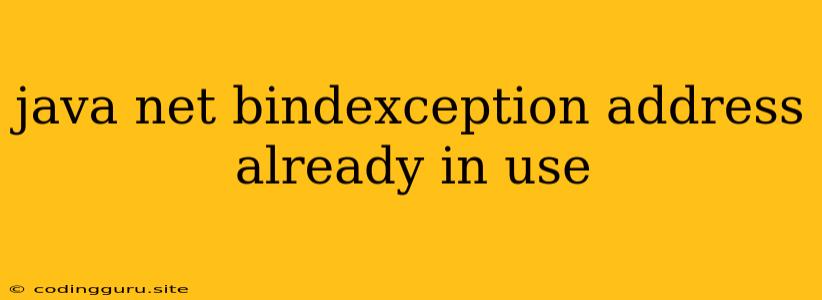The Enigma of "java.net.BindException: Address already in use": A Comprehensive Guide
Have you encountered the dreaded "java.net.BindException: Address already in use" error while working with Java applications? It's a common yet frustrating issue that can derail your development process. This error usually arises when your Java application attempts to bind to a specific port that is already occupied by another process. This means that a program is already listening for connections on that specific port.
Understanding the Error
To grasp the root cause of this exception, we need to delve into the basics of how network connections work. Every program that wants to communicate over a network needs a unique address and port combination. Think of a port as a specific "door" on your computer, allowing different applications to access the network.
When your Java application tries to establish a connection using a port that's already in use by another process, the operating system raises the "java.net.BindException: Address already in use" flag, indicating the conflict.
Identifying the Culprit
The first step towards resolving this issue is pinpointing the process that's currently holding onto the port. This can be achieved through different methods, depending on your operating system:
Windows:
-
Task Manager: Open the Task Manager (CTRL+SHIFT+ESC), navigate to the Details tab, and search for the process utilizing the problematic port. You can identify the port by examining the "PID" (Process ID) associated with the program.
-
Netstat: In the command prompt, use the command "netstat -a -b" to list all active network connections and their corresponding processes.
Linux/macOS:
-
Netstat: Execute the command "netstat -a -p" to display all active network connections and their associated processes.
-
lsof: Use the command "lsof -i :<port_number>" (replace
<port_number>with the problematic port) to display processes listening on the specific port.
Debugging Techniques
Once you've identified the process occupying the desired port, consider these troubleshooting steps:
1. Terminate the Conflicting Process: If the problematic process is no longer needed, you can simply terminate it. In Windows, right-click on the process in the Task Manager and choose "End task". In Linux/macOS, use the "kill" command followed by the process ID.
2. Modify the Listening Port: The most straightforward solution is to change the port used by your Java application. You can achieve this by modifying the code where the port number is specified. For example, if your application is using ServerSocket to listen on port 8080, change it to another available port like 8081.
3. Delay the Start: Sometimes, a delay in the program's start-up can resolve the issue. Wait for a few seconds before initiating the Java application to allow the other process to finish its tasks and release the port.
4. Explore Alternative Libraries: Depending on your application's needs, consider using different Java libraries for network operations. Libraries like Apache HttpComponents or Netty can offer more flexibility in handling port binding issues.
5. Utilize Port Scanning Tools: Port scanning tools can help identify available ports on your system. Popular tools include Nmap (for Linux/macOS) and Advanced IP Scanner (for Windows).
Example Code
Here's a simple Java code example demonstrating a BindException scenario and how to modify the code to avoid it:
import java.io.IOException;
import java.net.ServerSocket;
public class PortBindingExample {
public static void main(String[] args) {
try {
// Attempt to bind to port 8080
ServerSocket serverSocket = new ServerSocket(8080);
System.out.println("Server started on port 8080.");
} catch (IOException e) {
if (e.getClass() == java.net.BindException.class) {
System.err.println("Error: " + e.getMessage() + ". Port already in use.");
} else {
System.err.println("Error: " + e.getMessage());
}
}
}
}
Conclusion
The "java.net.BindException: Address already in use" exception is a common pitfall in Java network programming. Understanding the root cause and implementing the appropriate debugging techniques will help you overcome this hurdle and ensure smooth operation of your applications. Remember to carefully analyze your application's network configuration, identify conflicting processes, and consider alternative approaches to port binding.
